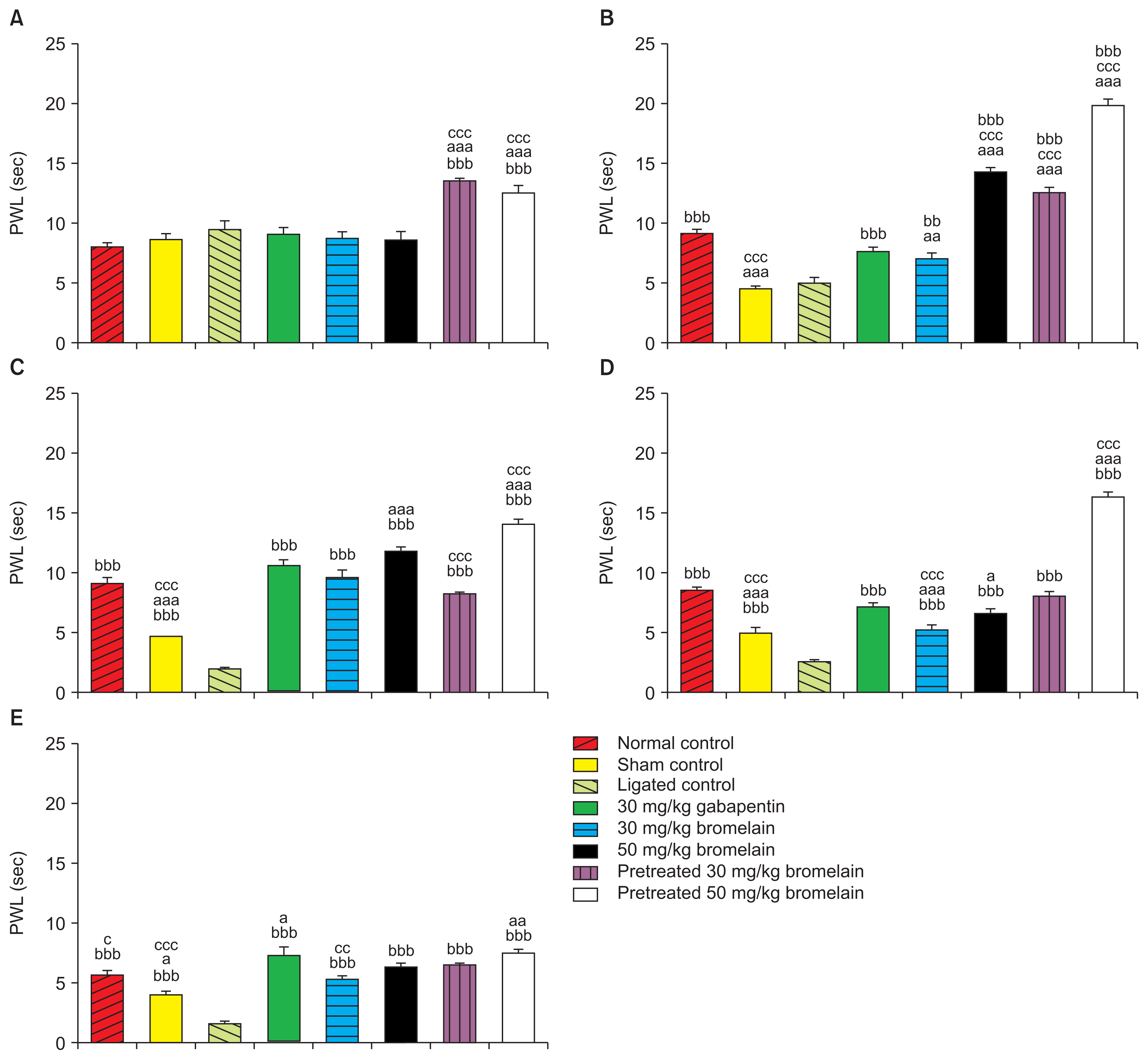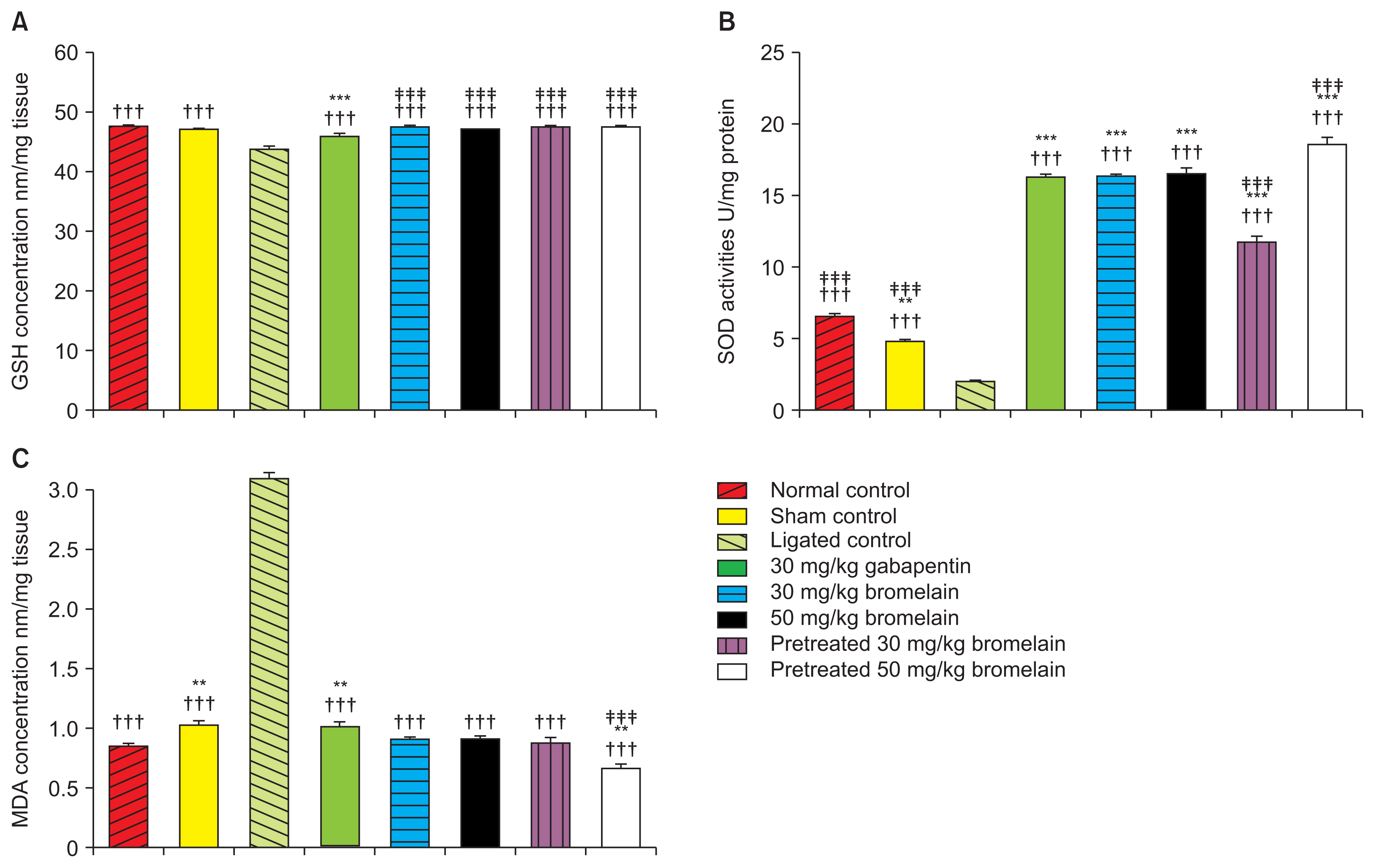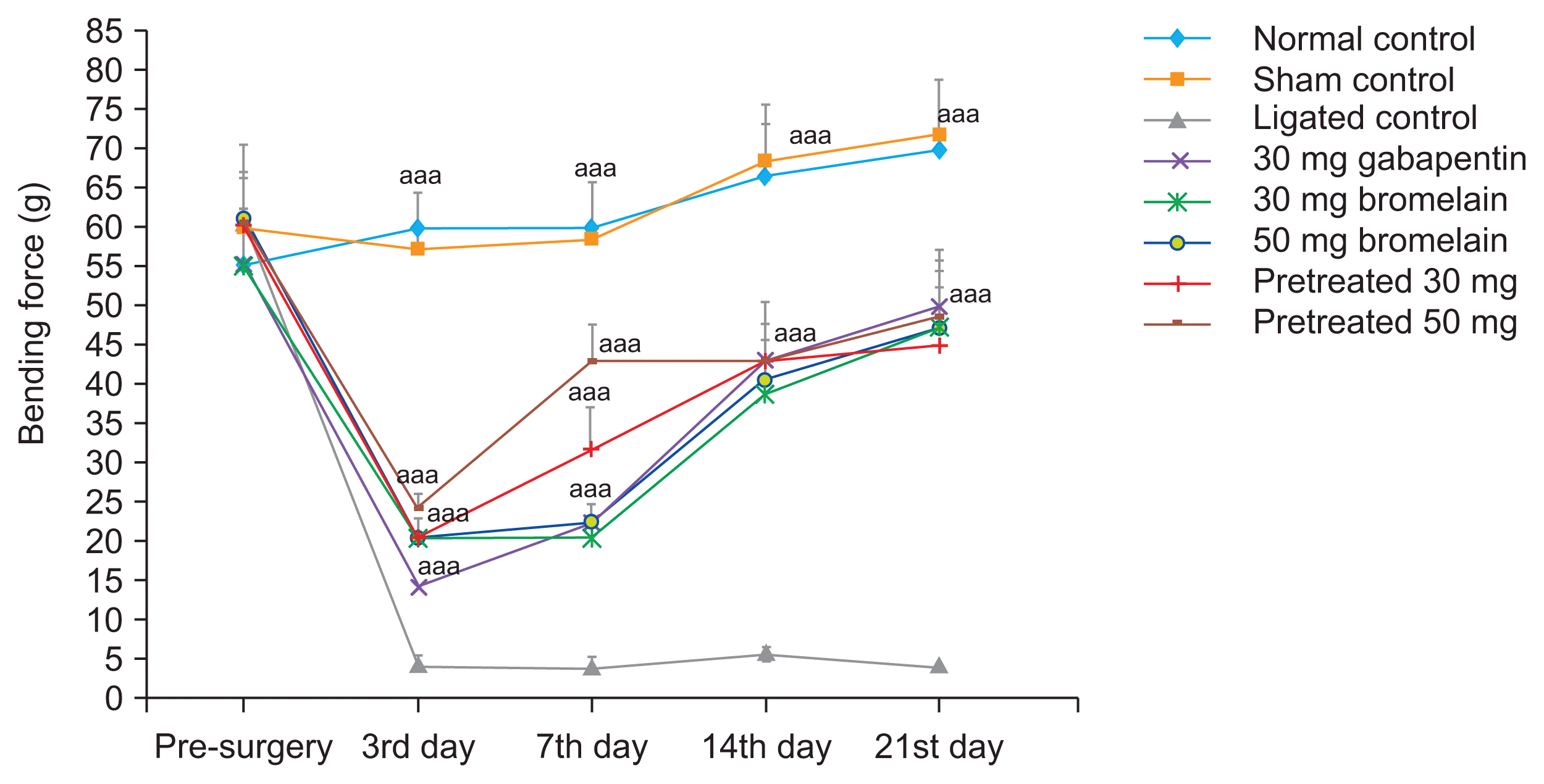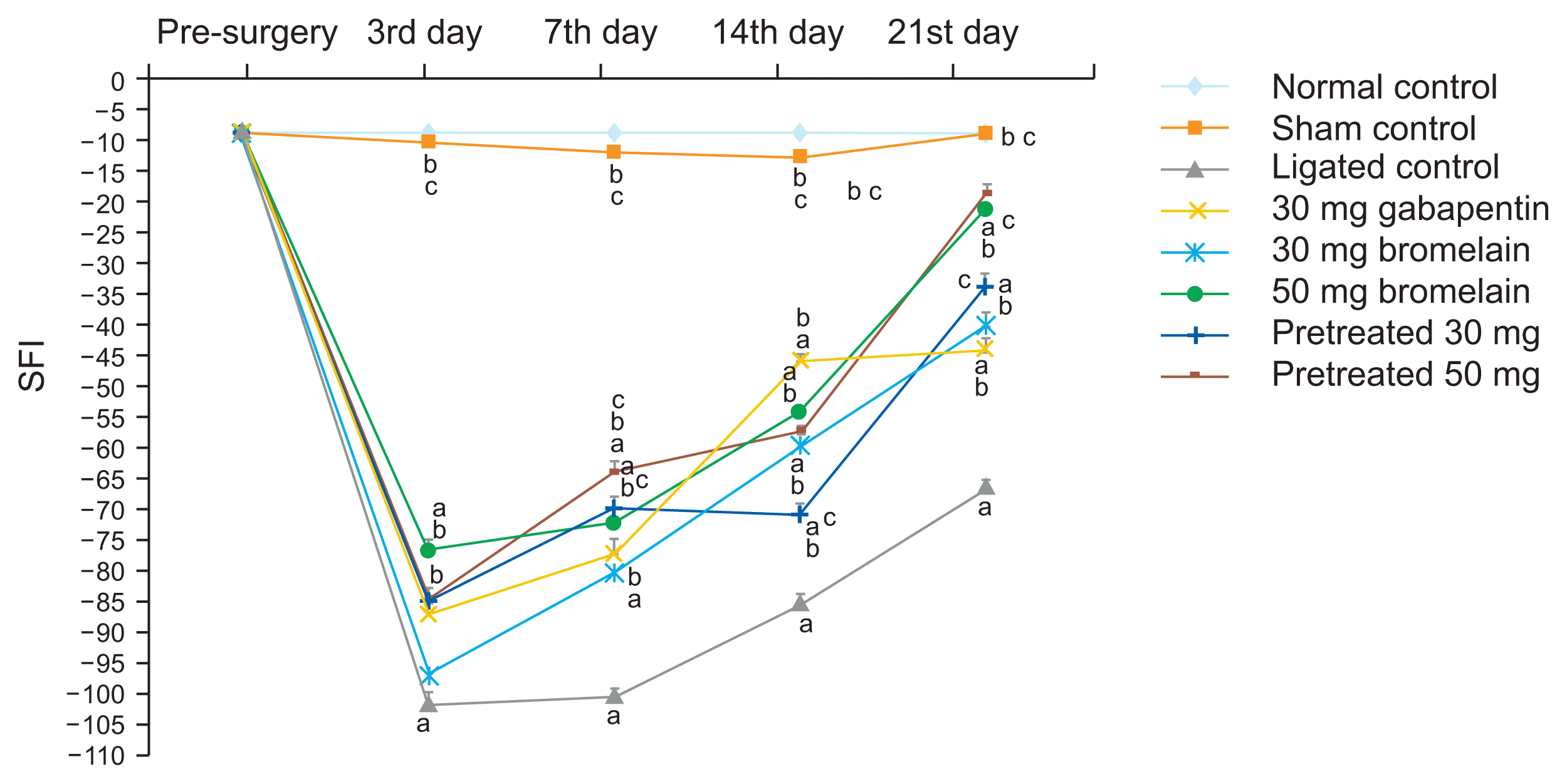1. Jensen TS, Finnerup NB. Allodynia and hyperalgesia in neuropathic pain: clinical manifestations and mechanisms. Lancet Neurol. 2014; 13:924–35. DOI:
10.1016/S1474-4422(14)70102-4. PMID:
25142459.

2. Muthuraman A, Singh N, Jaggi AS, Ramesh M. Drug therapy of neuropathic pain: current developments and future perspectives. Curr Drug Targets. 2014; 15:210–53. DOI:
10.2174/1389210200418434501. PMID:
24093749.

3. Kanyadhara S, Dodoala S, Sampathi S, Punuru P, Chinta G. Ethanolic extract of Aloe vera ameliorates sciatic nerve ligation induced neuropathic pain. Anc Sci Life. 2014; 33:208–15. DOI:
10.4103/0257-7941.147425. PMID:
25593400. PMCID:
4293747.

4. Duggett NA, Griffiths LA, McKenna OE, de Santis V, Yong–sanguanchai N, Mokori EB, et al. Oxidative stress in the development, maintenance and resolution of paclitaxel-induced painful neuropathy. Neuroscience. 2016; 333:13–26. DOI:
10.1016/j.neuroscience.2016.06.050. PMID:
27393249. PMCID:
4996646.

5. Zhang EJ, Song CH, Ko YK, Lee WH. Intrathecal administration of mesenchymal stem cells reduces the reactive oxygen species and pain behavior in neuropathic rats. Korean J Pain. 2014; 27:239–45. DOI:
10.3344/kjp.2014.27.3.239. PMID:
25031809. PMCID:
4099236.

6. Kim HK, Zhang YP, Gwak YS, Abdi S. Phenyl N-tert-butylnitrone, a free radical scavenger, reduces mechanical allodynia in chemotherapy-induced neuropathic pain in rats. Anesthesiology. 2010; 112:432–9. DOI:
10.1097/ALN.0b013e3181ca31bd. PMID:
20068451.

7. Negi G, Kumar A, Joshi RP, Sharma SS. Oxidative stress and Nrf2 in the pathophysiology of diabetic neuropathy: old perspective with a new angle. Biochem Biophys Res Commun. 2011; 408:1–5. DOI:
10.1016/j.bbrc.2011.03.087. PMID:
21439933.

8. Biswas M, Chan JY. Role of Nrf1 in antioxidant response element-mediated gene expression and beyond. Toxicol Appl Pharmacol. 2010; 244:16–20. DOI:
10.1016/j.taap.2009.07.034. PMID:
19665035. PMCID:
2837788.

9. Li W, Kong AN. Molecular mechanisms of Nrf2-mediated antioxidant response. Mol Carcinog. 2009; 48:91–104. DOI:
10.1002/mc.20465. PMID:
18618599. PMCID:
2631094.

10. Majid OW, Al-Mashhadani BA. Perioperative bromelain reduces pain and swelling and improves quality of life measures after mandibular third molar surgery: a randomized, double-blind, placebo-controlled clinical trial. J Oral Maxillofac Surg. 2014; 72:1043–8. DOI:
10.1016/j.joms.2013.12.035. PMID:
24589242.

11. Golezar S. Ananas comosus Effect on perineal pain and wound healing after episiotomy: a randomized double-blind placebo-controlled clinical trial. Iran Red Crescent Med J. 2016; 18:e21019. DOI:
10.5812/ircmj.21019. PMID:
27247780. PMCID:
4884440.

12. Sudjarwo SA. Anti-inflammatory and analgesic effect of bromelain in mice and rats. Univ Med. 2005; 24:155–60.
13. Jiang X, Yan Q, Liu F, Jing C, Ding L, Zhang L, et al. Chronic trans-astaxanthin treatment exerts antihyperalgesic effect and corrects co-morbid depressive like behaviors in mice with chronic pain. Neurosci Lett. 2018; 662:36–43. DOI:
10.1016/j.neulet.2017.09.064. PMID:
28982597.

14. Kilic FS, Sirmagul B, Yildirim E, Oner S, Erol K. Antinociceptive effects of gabapentin & its mechanism of action in experimental animal studies. Indian J Med Res. 2012; 135:630–5. PMID:
22771591. PMCID:
3401692.
15. Zhu YF, Wu Q, Henry JL. Changes in functional properties of A-type but not C-type sensory neurons in vivo in a rat model of peripheral neuropathy. J Pain Res. 2012; 5:175–92. DOI:
10.2147/JPR.S26367. PMID:
22792004. PMCID:
3392709.
16. Zhang MT, Wang B, Jia YN, Liu N, Ma PS, Gong SS, et al. Neuroprotective effect of liquiritin against neuropathic pain induced by chronic constriction injury of the sciatic nerve in mice. Biomed Pharmacother. 2017; 95:186–98. DOI:
10.1016/j.biopha.2017.07.167. PMID:
28843150.

17. Bain JR, Mackinnon SE, Hunter DA. Functional evaluation of complete sciatic, peroneal, and posterior tibial nerve lesions in the rat. Plast Reconstr Surg. 1989; 83:129–38. DOI:
10.1097/00006534-198901000-00024. PMID:
2909054.

18. Hunter FE Jr, Gebicki JM, Hoffsten PE, Weinstein J, Scott A. Swelling and lysis of rat liver mitochondria induced by ferrous ions. J Biol Chem. 1963; 238:828–35. PMID:
13955764.

19. Gutteridge JM, Wilkins S. Copper-dependent hydroxyl radical damage to ascorbic acid: formation of a thiobarbituric acid-reactive product. FEBS Lett. 1982; 137:327–30. DOI:
10.1016/0014-5793(82)80377-3. PMID:
6277694.
20. Misra HP, Fridovich I. The role of superoxide anion in the autoxidation of epinephrine and a simple assay for superoxide dismutase. J Biol Chem. 1972; 247:3170–5. PMID:
4623845.

22. Muthuraman A, Diwan V, Jaggi AS, Singh N, Singh D. Ameliorative effects of Ocimum sanctum in sciatic nerve transection-induced neuropathy in rats. J Ethnopharmacol. 2008; 120:56–62. DOI:
10.1016/j.jep.2008.07.049. PMID:
18762236.

23. Moini Zanjani T, Ameli H, Labibi F, Sedaghat K, Sabetkasaei M. The attenuation of pain behavior and serum COX-2 concentration by curcumin in a rat model of neuropathic pain. Korean J Pain. 2014; 27:246–52. DOI:
10.3344/kjp.2014.27.3.246. PMID:
25031810. PMCID:
4099237.

24. Ishola IO, Agbaje EO, Adeyemi OO, Shukla R. Analgesic and anti-inflammatory effects of the methanol root extracts of some selected Nigerian medicinal plants. Pharm Biol. 2014; 52:1208–16. DOI:
10.3109/13880209.2014.880487. PMID:
24697560.

25. Owoyele BV, Bakare AO. Analgesic properties of aqueous bark extract of Adansonia digitata in Wistar rats. Biomed Pharmacother. 2018; 97:209–12. DOI:
10.1016/j.biopha.2017.10.079. PMID:
29091868.

26. Shen N, Zhu J. Application of sciatic functional index in nerve functional assessment. Microsurgery. 1995; 16:552–5. DOI:
10.1002/micr.1920160809. PMID:
8538433.

27. Monte-Raso VV, Barbieri CH, Mazzer N, Yamasita AC, Barbieri G. Is the Sciatic Functional Index always reliable and reproducible? J Neurosci Methods. 2008; 170:255–61. DOI:
10.1016/j.jneumeth.2008.01.022. PMID:
18325595.

28. Hassler SN, Johnson KM, Hulsebosch CE. Reactive oxygen species and lipid peroxidation inhibitors reduce mechanical sensitivity in a chronic neuropathic pain model of spinal cord injury in rats. J Neurochem. 2014; 131:413–7. DOI:
10.1111/jnc.12830. PMID:
25051888. PMCID:
4221536.

29. Goel R, Tyagi N. Potential contribution of antioxidant mechanism in the defensive effect of lycopene against partial sciatic nerve ligation induced behavioral, biochemical and histopathological modification in wistar rats. Drug Res (Stuttg). 2016; 66:633–8. DOI:
10.1055/s-0042-112364. PMID:
27504866.

30. Luo ZD, Chaplan SR, Higuera ES, Sorkin LS, Stauderman KA, Williams ME, et al. Upregulation of dorsal root ganglion (alpha)2(delta) calcium channel subunit and its correlation with allodynia in spinal nerve-injured rats. J Neurosci. 2001; 21:1868–75. DOI:
10.1523/JNEUROSCI.21-06-01868.2001. PMID:
11245671. PMCID:
6762626.
31. Kim MJ, Lee JH, Jang JU, Quan FS, Kim SK, Kim W. The efficacy of combination treatment of gabapentin and electro-acupuncture on paclitaxel-induced neuropathic pain. Korean J Physiol Pharmacol. 2017; 21:657–66. DOI:
10.4196/kjpp.2017.21.6.657. PMID:
29200909. PMCID:
5709483.








 PDF
PDF Citation
Citation Print
Print





 XML Download
XML Download